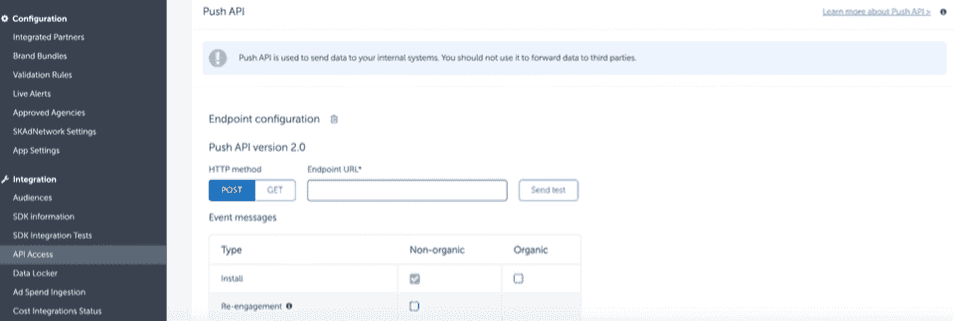AppsFlyer is an industry-leading mobile attribution and marketing analytics platform, provided as a Software-as-a-Service (SaaS). It offers exciting features to understand your customers better through intuitive dashboards, real-time data reports, and a unique deep linking technology.
You can send your AppsFlyer events to RudderStack by adding an endpoint that points to RudderStack, with AppsFlyer's Push API option. This way, you can capture all the relevant AppsFlyer events related to re-engagement, reattribution, in-app install events, etc. and send them to RudderStack.
This guide will help you set up AppsFlyer as a source in RudderStack.
Getting started
Follow these steps to set up your AppsFlyer source in the RudderStack dashboard:
- Go to your RudderStack dashboard and click on Add Source. Then, select AppsFlyer from the list of Event Stream sources, as shown:

Assign a name to your source and click on Next.
Your AppsFlyer source is now configured. Note the source Write key - this will be required to configure the endpoint URL in the later steps.

- Head over to your AppsFlyer account and navigate to the API Access section under Integration from the sidebar. Look for the Push API section, as shown:

- Add the Endpoint URL pointing to RudderStack in the following format:
<DATA_PLANE_URL>/v1/webhook?writeKey=<WRITE_KEY>
For more information on the data plane URL, refer to this section.
Make sure you add the source write key as query parameter to the URL. This is required to prevent the webhook from failing because of an invalid write key.
A sample endpoint URL is shown below:
https://hosted.rudderlabs.com/v1/webhook?writeKey=1bCenS7ynqHh8ETX8s5Crjh22JWe highly recommend validating the endpoint using the Send Test button.

- Finally, save the endpoint.
Event transformation
The AppsFlyer Push events are ingested into RudderStack after converting them into the RudderStack event format. For example, RudderStack converts the customer_user_id property set by AppsFlyer into userId.
RudderStack populates the following properties from AppsFlyer event payload into the RudderStack event:
| AppsFlyer Property | RudderStack Property |
|---|---|
customer_user_id | userId, context.traits.userId |
event_name | event |
event_time | timestamp, originalTimestamp |
ip | context.ip |
selected_timezone | context.timezone |
user_agent | context.userAgent |
bundle_id | context.app.namespace |
app_version | context.app.version |
app_name | context.app.name |
device_type | context.device.model |
wifi | context.network.wifi |
carrier | context.network.carrier |
platform | platform, context.os.name |
idfa | context.device.advertisingId (for iOS) |
android_id | context.device.advertisingId (for Android) |
appsflyer_id | context.externalId[0].value |
os_version | context.os.version |
city | traits.address.city, context.traits.address.city |
postal_code | traits.address.zip, context.traits.address.zip |
country_code | traits.address.country, context.traits.address.country |
Contact us
For queries on any of the sections covered in this guide, you can contact us or start a conversation in our Slack community.